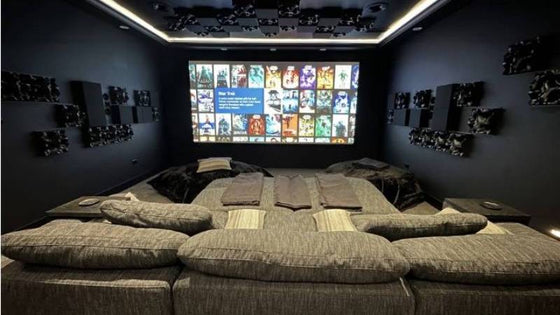Creating a system you love shouldn't be difficult. The Acoustic Frontiers blog is here to help.

Nearly everyone starts off with no knowledge of the importance of acoustics to final sound quality. Somehow they learn about it, whether from reading magazines or getting advice from their dealer. They learn that the room introduces a number of acoustic distortions which degrade sound quality. Yes, the sound quality you get is NOT just a result of what equipment you have. It is heavily influenced by the room. Some people get lucky and have a neutral-ish* room without any major acoustical distortions. Most, however, have some severe issues, particularly in the bass where the influence of room modes causes huge peaks and dips in frequency response leading to boomy bass and suckouts at other frequencies. * no untreated room is truly neutral, and even heavily treated rooms often have areas where performance deviates from perfect.

Peaks and dips due to room modes
This next part is very important, so pay attention. The ONLY way to know what your issues are is to measure your room using some kind of acoustic measurement tool like Room EQ Wizard, Fuzzmeasure or XTZ Room Analyzer. Without measuring you have no idea what issues your room has and therefore where you should focus your energy to get maximum sound quality improvements for minimum dollar investment. It's like shooting in the dark - "did I hit the target?" and the answer is typically "No, you missed it completely". Far too many prospective clients call me saying that they have spent thousands of dollars on acoustic treatment and still have major sonic issues. Most have not measured their rooms...don't be one of those people! For more information, read this article I co-authored with Ethan Winer of RealTraps: Everything you need to measure your room. And this one: Four approaches to room acoustic measurement.

Room EQ Wizard Spectrogram
So, this means you cannot really fix your room's acoustic issues by going on a forum, describing your room through a couple of photos and a sketch and asking for answers. Nor can you get it through the 'free consulting services' that many acoustic treatment manufacturers offer in the hope that you will buy their products. The only way you can truly know what your issues are is to take in room acoustic measurements of things like frequency response and how sound decays at different frequencies. From there you compare the measurements to best practices, understand the root cause of your room's acoustical issues and figure out what changes are required to improve things. If your room is predictable (non-open plan, new build construction) and you use good modeling tools you can get 90% of the way there with computer simulations.

Boundary Element Model study of frequency response across two rows in dedicated theater with six subwoofers
It's a bit like a doctor when they are trying to figure out what is wrong with a patient. They will use all their senses as well as medical tests to determine the illness and from there they will devise a plan to cure the patient. They do not just (we hope) semi-randomly start prescribing drugs, trying one here and another there, in an attempt to fix the issue. Like a doctor, you should measure your room, figure out what the issues are and from there devise an acoustic treatment plan*. * note that there are many ways to fix acoustical issues. Panels and bass traps are only one of them. You can also use, depending on the issue, room EQ, subwoofers, positional changes amongst other things.

RPG Harmonix K
When picking acoustical panels it is very important to understand how absorption or diffusion varies at different frequencies. A 1" fiberglass panel, for example, will absorb well above about 1kHz and then decrease in effectiveness below that. Part 2 of this article will give you some tips on how to match acoustical panels to room issues. It gets complicated VERY quickly. However for now let's make a simple rule that if you use acoustic treatment then it should be 100% effective down to your room's transition frequency. For now let's use 250Hz. It's actually very hard to hit that rule, especially with diffusers, which have to be very deep to work all the way down to 250Hz. But if you aim for that you are on the right track.

Absorption coefficient of Primacoustic Broadway panels in 1" (green), 2" (orange) and 3" (blue) thicknesses
So now we have covered absorbers and diffusers. But like we said earlier there are a lot of hybrid products out there that have some absorptive properties and some diffusive properties. They are absorptive at some frequencies and diffusive at others, often with a transition region where they are both absorptive and diffusive. Confusing I know, but hybrid products are a very useful type of acoustical panel.

RPG BAD panel, a classic hybrid absorber / diffuser. The transition from absorption to diffusion is managed by the drilled wooden template visible top right (the fabric that normally covers it has been cut away for this photo).
In part 2 we'll go more in depth on how to match treatment to room acoustic issues. If you have any comments, feel free to contact us!
Learn how early home theater design, layout, and acoustic treatment improve performance in new home construction.
This media room was intentionally designed to feel like part of the home—not a separate, tech-heavy space. Through careful acoustic planning, equipment integration, and final calibration, we achieved a room that is both beautiful to live in and immersive to experience.
"No other subwoofer system I’ve owned even comes close to what this room delivers. Reaching out to Acoustic Frontiers was one of the best decisions I’ve made—I highly recommend working with them if you want to get the most out of your theater."

Nyal Mellor, Founder, Acoustic Frontiers



Nyal Mellor
Author